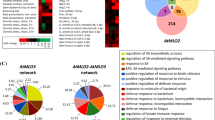Abstract
Arabidopsis thaliana (L.) Heynh. plants were challenged with Rhodococcus fascians at several developmental stages and using different inoculation procedures. A variety of morphological alterations was scored on the infected plants; some of them resembled phenotypes of A. thaliana mutants in their shoot apical meristem (SAM) organization. Infection with R. fascians did not affect SAM organization in wild type nor in SAM mutants. Anatomical studies on the new organs formed after infection with R. fascians demonstrated extensive bacterial colonization. Colonization and concomitant production of specific signals are the likely cause of malformations.




Similar content being viewed by others
References
Barton MK, Poethig RS (1993) Formation of the shoot apical meristem in Arabidopsis thaliana: an analysis of development in the wild type and in the shoot meristemless mutant. Development 119:823–831
Beeckman T, Viane R (1999) Embedding thin plant specimens for oriented sectioning. Biotech Histochem 75:23–26
Clark SE, Running MP, Meyerowitz EM (1993) CLAVATA1, a regulator of meristem and flower development in Arabidopsis. Development 119:397–418
Clark SE, Running MP, Meyerowitz EM (1995) CLAVATA3 is a specific regulator of shoot and floral meristem development affecting the same processes as CLAVATA1. Development 121:2057–2067
Cornelis K, Ritsema T, Nijsse J, Holsters M, Goethals K, Jaziri M (2001) The plant pathogen Rhodococcus fascians colonizes the exterior and interior of the aerial parts of plants. Mol Plant-Microbe Interact 14:599–608
Crespi M, Messens E, Caplan AB, Van Montagu M, Desomer J (1992) Fasciation induction by the phytopathogen Rhodococcus fascians depends upon a linear plasmid encoding a cytokinin synthase gene. EMBO J 11:795–804
Crespi M, Vereecke D, Temmerman W, Van Montagu M, Desomer J (1994) The fas operon of Rhodococcus fascians encodes new genes required for efficient fasciation of host plants. J Bacteriol 176:2492–2501
Desomer J, Dhaese P, Van Montagu M (1988) Conjugative transfer of cadmium resistance plasmids in Rhodococcus fascians strains. J Bacteriol 170:2401–2405
Felix G, Altmann T, Uwer U, Jessop A, Willmitzer L, Morris P (1996) Characterization of waldmeister, a novel developmental mutant in Arabidopsis thaliana. J Exp Bot 47:1007–1017
Goethals K, Vereecke D, Jaziri M, Van Montagu M, Holsters M (2001) Leafy gall formation by Rhodococcus fascians. Annu Rev Phytopathol 39:27–52
Laufs P, Dockx J, Kronenberger J, Traas J (1998) MGOUN1 and MGOUN2: two genes required for primordium initiation at the shoot apical and floral meristems in Arabidopsis thaliana. Development 125:1253–1260
Laux T, Mayer KFX, Berger J, Jürgens G (1996) The WUSCHEL gene is required for shoot and floral meristem integrity in Arabidopsis. Development 122:87–96
Leyser O, Day S (2003) Mechanisms in plant development. Blackwell Science, Oxford
Long J, Barton MK (2000) Initiation of axillary and floral meristems in Arabidopsis. Dev Biol 218:341–353
Lyndon RF (1998) The shoot apical meristem: its growth and development. Cambridge University Press, New York
Maes T, Vereecke D, Ritsema T, Cornelis K, Ngo Thi Thu H, Van Montagu M, Holsters M, Goethals K (2001) The att locus of Rhodococcus fascians strain D188 is essential for full virulence on tobacco through the production of an autoregulatory compound. Mol Microbiol 42:13–28
Manes C-L de O, Van Montagu M, Prinsen E, Goethals K, Holsters M (2001) De novo cortical cell division triggered by the phytopathogen Rhodococcus fascians in tobacco. Mol Plant-Microbe Interact 14:189–195
McConnell JR, Barton MK (1998) Leaf polarity and meristem formation in Arabidopsis. Development 125:2935–2942
Meyerowitz EM (1997) Genetic control of cell division patterns in developing plants. Cell 88:299–308
Miller JH (1972) Experiments in molecular genetics. Cold Spring Harbor Laboratory, Cold Spring Harbor, N.Y.
Murashige T, Skoog F (1962) A revised medium for rapid growth and bio assays with tobacco tissue cultures. Physiol Plant 15:473–497
Roussaux J (1975) Stimulation and inhibition reactions in plants infected by Corynebacterium fascians (Tilford) Dowson. Marcellia 38:305–310
Temmerman W (2000) The role of the fas locus in leafy gall formation by Rhodococcus fascians. PhD dissertation. Ghent University, Belgium
Temmerman W, Ritsema T, Simón-Mateo C, Van Montagu M, Mironov V, Inzé D, Goethals K, Holsters M (2001) The fas locus of the phytopathogen Rhodococcus fascians affects mitosis of tobacco BY-2 cells. FEBS Lett 492:127–132
Tilford PE (1936) Fasciation of sweet peas caused by Phytomonas fascians n. sp. J Agric Res 53:383–394
Valvekens D, Van Montagu M, Van Lijsebettens M (1988) Agrobacterium tumefaciens-mediated transformation of Arabidopsis thaliana root explants by using kanamycin selection. Proc Natl Acad Sci USA 85:5536–5540
Vereecke D, Burssens S, Simón-Mateo C, Inzé D, Van Montagu M, Goethals K, Jaziri M (2000) The Rhodococcus fascians-plant interaction: morphological traits and biotechnological applications. Planta 210:241–251
Vereecke D, Cornelis K, Temmerman W, Holsters M, Goethals K (2002) Versatile persistence pathways for pathogens of animals and plants. Trends Microbiol 10:485–488
Weigel D, Jürgens G (2002) Stem cells that make stems. Nature 415:751–754
Acknowledgements
The authors wish to acknowledge Jan Traas and Thomas Laux for the kind gift of the Arabidopsis mutants stm and wus, respectively; Danny Vereecke for critical reading of the manuscript; Rosemarijn Dreesen for assistance with the plant infiltrations; Rebecca Verbanck and Karel Spruyt for artwork; and Martine De Cock for help preparing the manuscript. This work has been supported by a grant from the Interuniversity Poles of Attraction Programme-Belgian Science Policy (P5/13). C-L.d.O.M. is indebted to the Coordenação de Aperfeiçoamento de Pessoal de Nível Superior (CAPES, Brasil) for a predoctoral fellowship.
Author information
Authors and Affiliations
Corresponding author
Rights and permissions
About this article
Cite this article
de O. Manes, CL., Beeckman, T., Ritsema, T. et al. Phenotypic alterations in Arabidopsis thaliana plants caused by Rhodococcus fascians infection. J Plant Res 117, 139–145 (2004). https://doi.org/10.1007/s10265-003-0138-y
Received:
Accepted:
Published:
Issue Date:
DOI: https://doi.org/10.1007/s10265-003-0138-y




